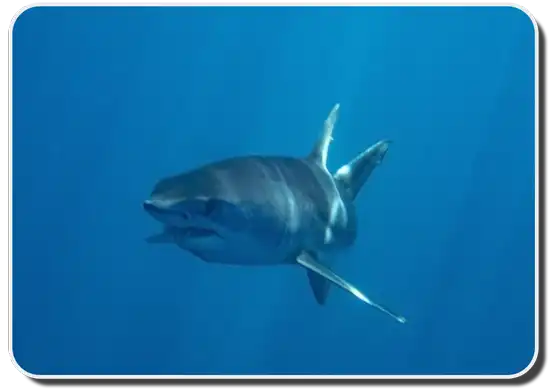The Mako Shark also called Isurus in the scientific community, is an incredible and extremely fast beast. Today, there are only two living species of Mako remaining. They are called the Longfin Makos and the Shortfin Makos.
The largest is the Longfin with a length of about 4.5 meters (14ft) and adults weigh in around 170 kilograms (375 pounds). Shortfin sharks are usually about half this size and weight.

Both species are easily identified due to their strange (and mean looking) teeth. These teeth are visible even when their mouths are closed. For simple identification, the Mako tends to look like a smaller version of the Great White Shark.
This shark loves jumping out of the water. Scientists still aren’t sure why they do this, but it’s theorized that they are searching for prey over the water surface.

What are Mako Sharks?
The mako shark is a small to medium-large predatory fish with a robust, cylindrical body. It has small but pointed, canine-like denticles at the base of each tooth, giving it a distinctive appearance. The head is rounded with a long, slender snout, and the dorsal fin is triangular with a low width. The caudal fin is small and crescent-shaped with a notch at the base of the tail. The coloration varies between populations but is generally gray-brown to gray-black above, with paler lower surfaces, and lighter ventral surfaces with a white underbelly. The fins are translucent and have a silver sheen. The mako shark is a fast swimmer and can reach speeds of up to 44.5 km/h (27.9 mph) in short bursts. Mako sharks are known for their hunting technique: they lie in wait for their prey in shallow bays and inlets, acting as ambush predators. They are ambush predators because they lie in wait for their prey to come close by before attacking. They usually feed on large, slow-moving bony fish.
Map Of The Mako Shark’s Habitat

What do Mako Sharks eat?
Mako sharks are obligate carnivores, obtaining all their nutritional requirements from proteinaceous prey. The teeth, which are embedded in the sides of the jaws, function like a pair of scissors, cutting open their prey, which is then swallowed whole. Mako sharks are not known to have the ability to break down their prey with enzymes in the stomach like most other carnivores. Their diet consists primarily of bony fish, though they have been observed eating other small vertebrates and even scavenging on the stomach contents of stranded marine mammals. Mako sharks are opportunistic predators, meaning they have to be in close proximity to their prey in order to feed. In order to maximize their chances of successfully finding and capturing prey, Mako sharks have been observed to frequently swim at an angle above the sea floor in the vicinity of their prey.
How do Mako Sharks hunt?
Mako sharks lie in wait for their prey to approach within a few hundred meters and then lunge from below to grab it with their teeth in front of their body. They then chomp down on the prey and break it apart with their strong jaws. Mako shark teeth are very strong, with some documented specimens having been able to bite through steel net rings. Bony fish are the most common prey items of mako sharks, but they have also been observed feeding on bird eggs, small turtles, and other small animals. The sharks generally feed in areas where fish gather in large numbers, such as over coral reefs and near the mouths of inlets.
Mako Shark Speed
This is the fastest shark species in the world. They average an incredible 60mph when hunting for prey!
Lifespan
The lifespan of a Mako Shark is from 28 to 35 years. As with many other sharks, it appears this species is living longer as time progresses. The cause for this is largely unknown. We do know that females are getting older at a quicker pace than males.

Human Interaction
The largest threat to this animal, like so many other shark species, are humans. They frequently get caught in fishnets and are sometimes caught by commercial fisheries for fins, oil, teeth, and the shark skin. They are also used for game fishing.
There are no attacks on humans recorded from Shortfin sharks. Longfin sharks have attacked humans before, but it’s almost always the result of being caught in fishing nets or on fishing hooks and lines.

Twelve Astonishing Facts About Mako Sharks
Mako Sharks, also called the Blue Pointer Sharks or Bonito Sharks, are two species of sharks in the Mackerel Shark family. They look very similar to their Mackerel Shark cousins the Great White Shark and the infamous prehistoric Megalodon Shark. However, Mako Sharks are a very different species of shark that have unique biological and behavioral characteristics. So here is everything you’d ever want to know about Mako Sharks:
1. Mako Sharks Are The Fastest Sharks In The World
Clocking in at record breaking speeds of 60 mph (96 kph), the Mako Shark is not only the fastest shark in the water but one of the fastest creatures on earth. They can use this fast speed to breach the water shooting up to heights of 30 ft (9 m) above the water line. This speed has earned them the nickname “The Peregrine Falcon of the Sea.” Mako Sharks not only swim very fast but they are incredibly active swimmers traveling an average of 36 m (58 km) every single day.
2. They Are Extremely Intelligent
Mako Sharks have the largest brain to body ratios of all sharks. They have extremely impressive critical reasoning and social skills. Their brain capacity is so large that unlike other sharks, they do not rely on electroreception to navigate the oceans or sense prey. Instead they rely on smell, hearing, and vision. They are also able to quickly identify if a human is a threat to them and will allow researchers to hand feed them and touch them.
3. They Love Warm Waters
Both species of Mako Shark, the Shortfin and the Longfin Mako Shark prefer to live in tropical and temperate waters. They are found in the Atlantic, Pacific, and Indian Oceans along the equatorial line. They are rarely found in water colder than 61°F (16° C), except in extreme cases when hunting. They tend to hunt in waters that are 490 ft (150 m) deep, but will often hunt along coastlines around islands and inlets.
4. Warm Blooded
Mako Sharks are one of only five species of endothermic sharks. That means it can regulate its body temperature internally, essentially being considered a warm-blooded animal. Scientists believe that Mako Sharks are so fast because they are endothermic. Warm blood makes their muscles strong and more efficient so they can expel a lot of energy more efficiently.
5. Mako Sharks Have To Swim Constantly To Survive
Mako Sharks are “obligate ram ventilators” which means they breath oxygen from the water washing over their gills. If they ever stopped swimming they would die. So instead of sleeping, they have periods of inactivity where they rest and restore their energy.
6. Opportunistic Hunters
Since Mako Sharks require a lot of energy to swim long miles, they are opportunistic hunters. They have a diverse diet that includes fish, sharks, cephalopods, dolphins, seabirds, sea and mammals. Mako Sharks will eat everything they can get their hands on whenever they find it and store the energy for times when they cannot find prey.
7. Mako Sharks Are Smart, Aggressive Hunters
When Mako Sharks find prey, they will stalk them by swimming underneath them. They are countershading a metallic blue, so they blend seamless into the deep water. When they perfect moment to attack, they will quickly lunge upwards and bite chunks off their prey, circling back again and again until the prey is immobilized and they can feast. Prey rarely notices when a Mako Shark is about to attack, so Mako Sharks are rarely injured while feeding.
8. Mako Sharks Love To Eat Swordfish
An unusual favorite meal of Mako Sharks is Swordfish. Mako Sharks love them so much, when you find a Swordfish, it’s likely you will find a Mako Shark lurking nearby – especially during Swordfish mating season. Swordfish is not easy prey though, many Mako Sharks have been found injured or killed by a swordfish. Scientists believe they may enjoy Swordfish so much because of the thrill of the hunt.
9. They Don’t Give Birth Very Often
Mako Shark mating cycles only happen once every 1.5 years. Female Mako Sharks then have gestation periods that last eighteen months. So Mako Sharks mate at a maximum of once every three years. Since female Mako Sharks do not reach sexual maturity until 19-20 years, and only live an average of 30 years, a Mako Shark may only give birth 3 times their entire lives.
10. Mako Sharks Are Sacred To The Maori
Mako Sharks get their name from the Maori word for “shark.” Mako Sharks are a part of Maori legend and are consider guiding spirit animals that help guard humans from danger. Mako Shark teeth are also highly prized by the Maori people and are worn as jewelry by tribal leaders and the most skilled warriors as a status symbol.
11. Prized By Sport Fisherman
With their incredible speeds, sport fisherman love to hunt Mako Sharks. They provide a real thrill for sport fisherman because they will flip and fight once caught, making them hard to keep on the line and pull aboard once caught. Since Mako Sharks are under threat of endangerment, responsible sport fisherman practice catch and release, where they enjoy the thrill of the catch but they release the shark back in the water unharmed.
12. They Are Considered A Vulnerable Species
Mako Sharks are not only prized by sport fisherman, they are also considered a valuable shark for shark finning. Also, since Mako Sharks are opportunistic, they will attack schooling fish that have been caught in fishing nets. The Mako Shark can get tangled in the nets and die as a by-catch. So their population is under threat from commercial fishing. Since they are slow to reproduce, like most sharks their population numbers have begun to dwindle in recent years and are list as “Vulnerable” species on the International Union for the Conservation of Nature’s Red List.
